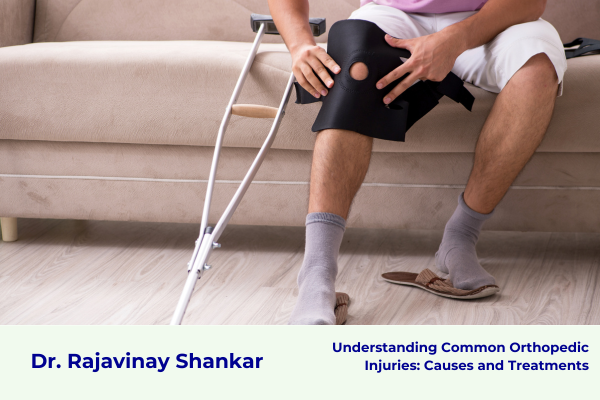Orthopedic injuries affect the musculoskeletal system, which includes bones, joints, ligaments, tendons, and muscles. These injuries are common, particularly among athletes, active individuals, and even people leading a sedentary lifestyle. Understanding the causes, symptoms, and treatment options for common orthopedic injuries can help you manage them effectively and prevent future complications.
As one of the best orthopedic surgeons in Kolkata, Dr. Rajavinay Shankar specializes in diagnosing and treating various orthopedic injuries. In this blog, we will explore some of the most common orthopedic injuries, their causes, and the treatment options available.
Common Orthopedic Injuries
- Sprains and Strains
- Sprains occur when ligaments (the tissue connecting bones to each other) are stretched or torn, usually due to a fall or twisting motion. Common areas affected include the ankle, knee, and wrist.
- Strains involve the stretching or tearing of muscles or tendons (tissue connecting muscles to bones), often caused by overexertion or improper lifting techniques.
- Fractures Fractures are broken bones that occur due to trauma, falls, or accidents. There are several types of fractures, such as:
- Simple fractures: A clean break with minimal damage to surrounding tissues.
- Compound fractures: When the bone pierces the skin.
- Stress fractures: Tiny cracks in the bone caused by repetitive force or overuse.
- Dislocations A dislocation happens when a bone is forced out of its normal position in a joint, commonly occurring in the shoulder, knee, or hip. Dislocations often result from a fall, blow, or sudden twisting motion.Treatment: Immediate medical attention is necessary to reposition the bone. After reduction (repositioning the bone), rest, immobilization, and physical therapy may be recommended for recovery.
- Tendonitis Tendonitis is the inflammation of a tendon, often caused by repetitive motions or overuse. Common areas affected include the shoulder (rotator cuff tendonitis), elbow (tennis elbow), and Achilles tendon.Treatment: Rest, anti-inflammatory medications, physical therapy, and in severe cases, corticosteroid injections or surgery, may be necessary to reduce inflammation and alleviate pain.
- Meniscus Tears The meniscus is a cartilage that cushions the knee joint. A meniscus tear often occurs during sports involving sudden stops and turns, like basketball or soccer.Treatment: Mild tears may heal with rest and physical therapy, while severe cases might require arthroscopic surgery to repair or remove the damaged cartilage.
Causes of Orthopedic Injuries
Orthopedic injuries can result from a variety of factors, including:
- Sports-related activities: High-impact or repetitive sports like football, running, or tennis often lead to strains, sprains, and fractures.
- Accidents and falls: Sudden falls or collisions can cause fractures, dislocations, or ligament tears.
- Overuse: Repetitive movements over time can cause stress on muscles, tendons, and bones, leading to conditions like tendonitis or stress fractures.
- Age-related wear and tear: Conditions like arthritis and osteoporosis make bones more prone to fractures and joints more susceptible to injury.
Treatment Options
The treatment of orthopedic injuries varies based on the type and severity of the injury. Here are common treatment approaches:
- Conservative Treatment: Most minor injuries, such as sprains, strains, and mild fractures, can be treated with non-surgical options. This includes:
- Rest and immobilization.
- Ice packs and anti-inflammatory medications.
- Physical therapy to restore mobility and strength.
- Surgical Treatment: For severe injuries, surgery may be required. Some surgical interventions include:
- Arthroscopy for torn ligaments and tendons.
- Open reduction and internal fixation (ORIF) for fractures.
- Joint replacement surgery for advanced arthritis or joint damage.
Conclusion
Orthopedic injuries can affect anyone, whether you’re an athlete or just going about your daily activities. Recognizing the signs and symptoms early and seeking professional help can prevent long-term complications. Dr. Rajavinay Shankar, one of the best orthopedic surgeons in Kolkata, offers comprehensive treatment options for all types of orthopedic injuries, helping patients regain mobility and improve their quality of life.

